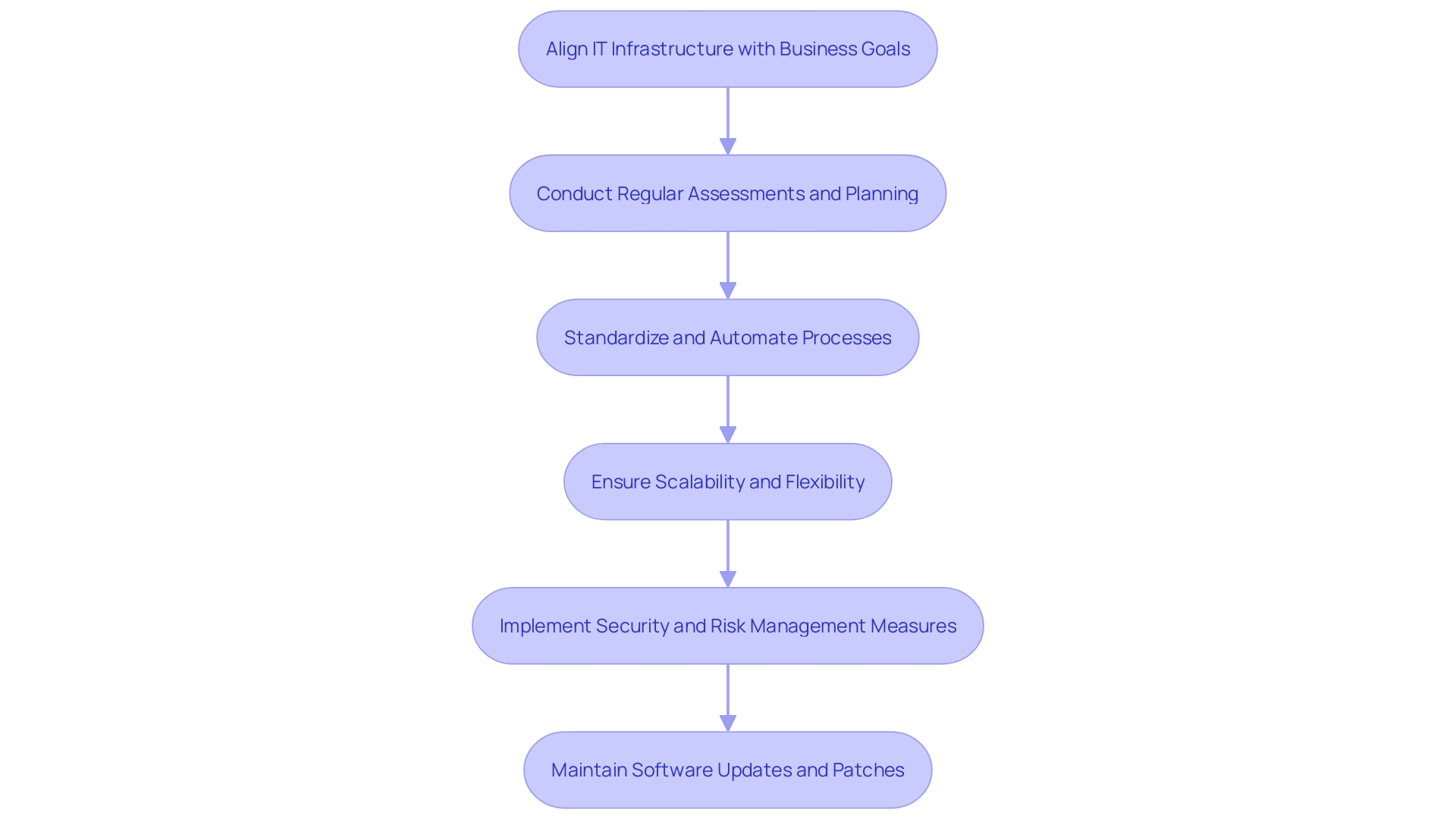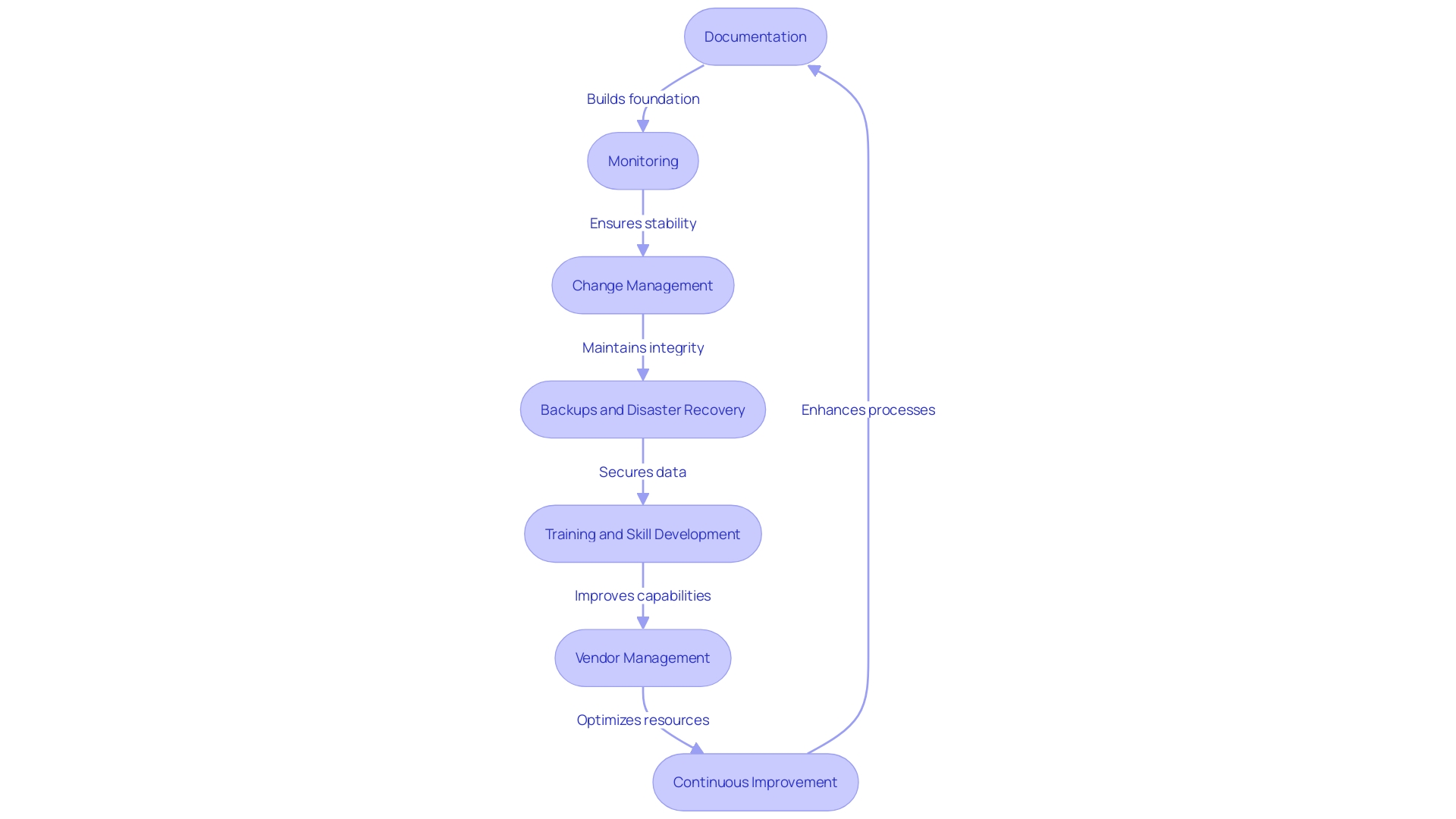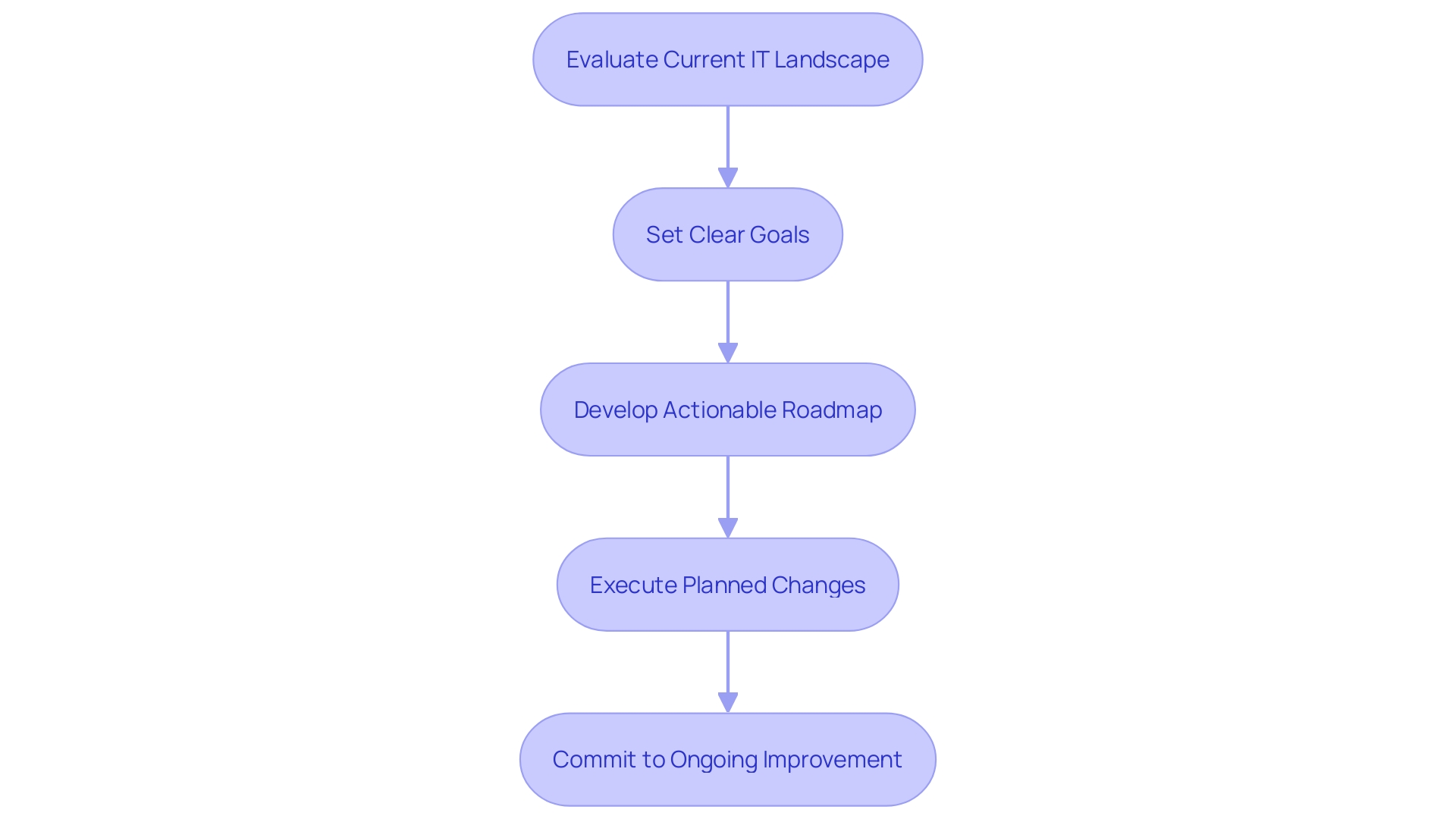Introduction
A solid IT infrastructure is crucial for the success of any modern business. It serves as the backbone, enabling seamless operations and strategic agility. However, managing and optimizing IT infrastructure can be a complex task.
In this article, we will explore the essential components of IT infrastructure, the importance of effective management, key strategies for optimization, best practices, challenges, future trends, and the implementation of efficient IT infrastructure management. By understanding these key aspects, businesses can ensure their IT infrastructure robustly supports their objectives while adapting to the evolving technological landscape.
Components of IT Infrastructure
A robust IT system is the foundation of any contemporary enterprise, facilitating smooth operations and strategic flexibility. At its heart, IT framework consists of vital components that must be skillfully controlled and coordinated to guarantee optimal performance and security.
Firstly, hardware is critical as it forms the tangible aspect of IT infrastructure. This encompasses servers, computers, routers, and switches, which are indispensable for establishing the physical framework of the organization's technology landscape.
Software, the second component, is equally vital. It includes operating systems, applications, and middleware that work in tandem with the hardware to facilitate specific functions and processes, turning raw computing power into valuable tools for the business.
Networking is the third pillar, connecting various hardware elements across the organization and beyond, thereby forming an integrated system that allows for efficient information transfer and communication.
Data centers are the repositories of an organization's digital assets. They house servers, storage systems, and networking equipment, playing a pivotal role in information storage, management, and processing.
Finally, security is the linchpin that safeguards the entire IT system. Robust security protocols are essential to safeguard against cyber threats, unauthorized access, and breaches, thus maintaining the integrity and confidentiality of business operations.
Case studies, such as that of Jeju Dream Tower, illustrate how meticulously planned and executed IT systems can support large-scale, complex operations while enhancing the user experience. Similarly, the use of PartsBox in the Schanzer Racing Electric case study demonstrates how specialized software can optimize project outcomes in a high-performance setting.
In a time where laws like Moore's Law govern rapid progress, and regulations like GDPR require strict governance of information, the strategic assessment of IT system elements becomes vital. This not only involves comprehending the cost and risk associated with each data element but also assessing their criticality to the industry, as per the digital economy statistics.
By thoroughly grasping these IT system elements, organizations can establish specific objectives for their technology plan, detect possible weaknesses, and optimize operations to facilitate a strong digital economy.
The Importance of IT Infrastructure Management
The importance of IT management cannot be underestimated in today's corporate landscape, where a smooth integration of digital and physical domains is a crucial driver of success. Robust management ensures that systems are consistently reliable and available, reducing interruptions and maximizing uptime, therefore bolstering business operations. As demonstrated by Siemens Digital Industry, which plays a crucial role in the manufacturing and development of everyday essentials through industrial automation and software, having a state-of-the-art IT system is essential to bridging the digital-physical divide and achieving operational excellence.
Scalability and flexibility are also key benefits, as demonstrated by Pima Community College's network transformation under the direction of CTO Jack Satterfield. The institution's capability to meet the rapidly evolving needs of its diverse student body and support regional industries is made possible through a streamlined and agile IT network.
Efficiently managing IT systems is a direct contributor to cost savings. For instance, the City of Helotes in Texas saw a dramatic shift in asset management and financial tracking with the implementation of a more structured approach, highlighting the importance of visibility and control in technology expenditure.
Ensuring security and compliance are essential for the efficient handling of IT systems, with strict security protocols being crucial to safeguard confidential information. This is critical in maintaining compliance with industry regulations and standards, as the ongoing evolution of cloud privacy and serverless models demand meticulous attention to data protection and management.
Finally, the durability of an organization is closely linked to its management of IT systems, which should include strategies for disaster recovery and backup. These strategies are integral in safeguarding business continuity in the face of unplanned disruptions, ensuring that the enterprise remains robust and capable of withstanding system failures or natural catastrophes. As we continue to observe an exponential rise in data generation, especially at the edge due to advancements in IoT, AI, and machine learning, the strategic significance of centralized data management and security within IT systems cannot be overstated.
Key Strategies for IT Infrastructure Optimization
To enhance IT infrastructure in line with organizational objectives, consider these essential strategies:
-
Alignment with Business Goals: IT infrastructure must be in harmony with the enterprise's strategic aims. Comprehending the organization's unique requirements and priorities is crucial.
-
Regular Assessment and Planning: A continual evaluation process is vital for pinpointing improvement opportunities and preparing for future expansion and technological evolution.
-
Standardization and Automation: Establishing uniform procedures and automating monotonous tasks boosts operational efficiency, diminishes errors, and enhances productivity.
-
Scalability and Flexibility: IT systems must be engineered for growth, allowing for scalable and agile solutions that can evolve with business demands. This encompasses scalable computing resources, adaptable software solutions, and agile networking setups.
-
Security and Risk Management: Implementing stringent security protocols, such as firewalls, encryption, and stringent access controls, is imperative for defending against cyber threats and managing risks.
-
To maintain security and stay current with emerging advancements and industry best practices, regular software updates, patches, and maintenance are essential.
For example, UOB Kay Hian, a leading Asian brokerage firm, exemplifies these strategies by providing their prestigious client base with cutting-edge tools and technologies, which support their complex trading environments. Similarly, recent advancements like the L4S internet standard and China's underwater center demonstrate the transformative potential of innovative IT infrastructure solutions.
Furthermore, IT leaders are increasingly recognizing the significance of information consolidation across their enterprises. By adopting approaches that encourage the exchange of information and dismantling information barriers, organizations are better positioned to harness the complete worth of their digital transformation endeavors. Executives, while not required to delve into technical specifics, should have a robust understanding of how data and analytics propel internal and external processes, appreciating the value of both structured and unstructured data.
Ultimately, the process of enhancing IT systems involves meticulous strategizing, harmonization with organizational objectives, and the implementation of adaptable, reliable, and streamlined technologies. By adhering to these guidelines, organizations can ensure that their IT systems strongly support their business objectives while adjusting to the changing technological landscape.

Best Practices for IT Infrastructure Management
Mastering the complex terrain of IT management necessitates a strategic method that guarantees operational efficiency while also acknowledging the swiftly changing technological landscape. Here is a comprehensive guide to the best practices essential for successful IT infrastructure management:
-
Documentation is the cornerstone of effective IT management. Detailed records of network diagrams, hardware and software inventories, and configuration specifics form a crucial foundation for troubleshooting, upgrades, and strategic planning.
-
Monitoring and Performance Management play a pivotal role in preempting disruptions. Utilizing advanced monitoring tools enables organizations to keep a vigilant eye on the performance and health of their IT assets, ensuring high availability and prompt issue resolution.
-
Change Management is of paramount importance to safeguard seamless operations. A formalized process for managing updates and modifications, accompanied by rigorous testing and documentation, aligns IT evolution with business objectives and mitigates risk.
-
Regular Backups and Disaster Recovery are essential for maintaining information integrity. Implementing consistent backup protocols and a reliable disaster recovery strategy is critical to minimize downtime and protect against data loss.
-
Training and Skill Development ensures that IT personnel remain at the forefront of technological innovation. Investing in ongoing learning and professional development equips the team with the knowledge to manage and leverage emerging innovations effectively.
-
Vendor Management enhances operational capabilities through strategic partnerships. Strong relationships with technology providers keep organizations informed about the latest updates, patches, and features, which is crucial for maintaining a competitive edge.
-
Continuous Improvement is the driving force behind IT infrastructure resilience and relevance. Continuous evaluation and improvement of IT practices ensure they keep up with demands and the dynamic tech landscape.
Supporting these practices, a case study of an e-commerce business's architectural design emphasizes the importance of low-latency, secure, and swiftly retrievable user relational information. Additionally, a focus on fault tolerance, high availability, and stringent security measures, both at rest and in transit, underscores the need for meticulous IT infrastructure management.
According to the most recent industry knowledge, it is stated that the worldwide center capex is expected to reach $400 billion by 2027. This emphasizes the strategic value of centers and the necessity for organizations to accurately measure the resources required for enduring success. Utilizing network monitoring tools to fortify security and the anticipation of emerging technologies like AI are key strategies in the current technology landscape.
A Gartner report emphasizes the significance of constructing solutions that bring value to both internal and external stakeholders, echoing the requirement for IT decision-makers to cultivate data centers that are resilient, scalable, and in line with growth. Furthermore, embracing advancements in AI Trust, Risk and Security Management (AI TRiSM) is critical for safeguarding investments and fostering innovation. These practices together guarantee that IT systems stay strong, adaptable, and able to promote organizational achievement.

Challenges in IT Infrastructure Management
Navigating the complex terrain of IT systems is a crucial task for businesses aiming to retain a competitive advantage. Challenges in this domain are multifaceted and require astute management to overcome. Firstly, the inherent complexity of IT systems, with its diverse array of tools and procedures, necessitates a deep well of expertise and meticulous planning. A second pressing concern is the ever-evolving realm of cyber threats; staying ahead of security risks demands constant vigilance and the deployment of robust security frameworks.
Budgetary limitations pose another significant hurdle, potentially hindering the acquisition of state-of-the-art equipment or the recruitment of specialized IT staff. Moreover, as a business expands, its IT infrastructure must scale up to meet growing demands, a task that can prove daunting without foresight and strategy. Finally, the lasting presence of older systems poses a distinct challenge — their incorporation with more recent advancements can be a intricate and time-consuming undertaking.
Recent studies, like the one conducted by RAND researchers, have highlighted the importance of comprehensive assessment and strategic international collaboration, particularly in advancing fields like quantum technology. This highlights the wider concept that IT management is not only an internal matter but also a part of the global tech ecosystem.
As organizations aim to stay current and efficient, it's crucial to recognize the role of engineering in fostering innovation. Vanessa Sochat's work highlights the overlooked yet crucial role of engineers in orchestrating and managing the tools that empower research and development. Similarly, partnerships, as exemplified by Siemens Digital Industries, play a vital role in driving digital transformation through collaborative efforts that integrate and digitize the entire value chain.
To surmount these challenges, it's beneficial to draw inspiration from the methodologies used in IT mapping projects, where setting clear goals and understanding the scope are fundamental to success. Whether the aim is to identify vulnerabilities, optimize processes, or gain a deeper comprehension of IT systems, the path forward involves strategic goal setting and embracing a culture of innovation, as suggested by arXivLabs' experimental projects.
To summarize, the management of IT systems is a multifaceted undertaking that necessitates a well-rounded strategy, taking into account not only the complexities and challenges but also the ever-changing nature of technology and the significance of strategic planning and global cooperation.
Future Trends in IT Infrastructure
As IT systems continue to be the foundation of modern enterprises, monitoring emerging trends is a crucial task. Cloud computing, for instance, is gaining traction as companies seek scalable and cost-effective solutions. A recent surge in enterprise spending on cloud services, with over $76 billion invested globally in the first quarter, underscores the robust 21% growth from the previous year, indicating a clear shift towards cloud-based solutions.
The growth in edge computing is another significant trend. By processing data closer to where it is generated, edge computing minimizes latency and fosters real-time analytics, proving essential for operations that cannot afford delays.
In the field of IT management, the incorporation of artificial intelligence (AI) and machine learning is transforming the manner tasks are automated, efficiency is enhanced, and security is improved. The upcoming era of AI, with advancements pushing beyond current capabilities, promises to strengthen public confidence significantly, especially in large-scale cyber applications.
The increasing number of Internet of Things (IoT) devices requires a system capable of supporting their connectivity needs and the processing of the information they produce. With IoT devices becoming increasingly prevalent, IT systems must adjust to effectively handle the data deluge.
The idea of software-defined systems (SDS) is reshaping flexibility within IT environments. Abstracting hardware components and managing them through software, SDI provides agility that traditional physical infrastructures lack. This software-centric approach aligns with the increasing awareness of socio-technical architecture, where the system design not only considers the digital aspects but also the people interacting with it.
Furthermore, the emphasis on Green IT reflects the increasing environmental consciousness within the IT sector. Organizations are seeking sustainable solutions that minimize energy consumption and reduce the environmental impact of their IT operations.
To ensure that these trends deliver sustained value, it is crucial for organizations to be intentional in their technology investments, aligning them with broader objectives like safeguarding past investments, crafting suitable solutions for stakeholders, and adapting to the evolving external and internal landscapes of their operations. According to industry experts' observations, the interaction of technical and ethical factors will keep molding the IT scenery, highlighting the importance of ethical and societal deliberations in IT development.
Implementing Effective IT Infrastructure Management
To establish an efficient IT infrastructure that aligns with organizational strategy, several critical steps must be undertaken. Initially, it's pivotal to evaluate the current IT landscape by pinpointing strengths and weaknesses, which can influence future improvements. This echoes the experience of a conglomerate with 17 subsidiaries, which tackled data silos by centralizing ERP systems to foster better decision-making.
Next, setting clear goals is essential. These objectives should resonate with the overarching business plans, akin to how Public Works in Helotes, Texas, began tracking asset conditions to make more informed decisions.
Developing an actionable roadmap is another key step, charting the path to achieve these objectives. Resource allocation is crucial; without adequate funding, personnel, and tech, initiatives may falter. For instance, the OneAstec project required a robust platform to standardize processes, a goal supported by the strategic advice of PwC and cloud technology solutions from Oracle Cloud.
Executing the planned changes demands adherence to best practices and a solid change management strategy. Monitoring and evaluation are ongoing processes to measure IT system performance and the effectiveness of changes. This is akin to understanding the lifespan of network devices and software components, as highlighted in recent news articles stressing the importance of modernizing enterprise architecture.
The process is not complete without an ongoing commitment to improvement. This involves regularly reassessing IT management practices, drawing inspiration from leading IT companies like Comarch, whose services are trusted globally across a gamut of industries.
This comprehensive approach not only ensures IT infrastructure is current and functional but also positions organizations to retain top talent by offering growth opportunities beyond financial compensation, as industry trends suggest.

Conclusion
In conclusion, effective management and optimization of IT infrastructure are crucial for the success of modern businesses. A solid IT infrastructure serves as the backbone, enabling seamless operations and strategic agility. It comprises essential components such as hardware, software, networking, data centers, and security, which must be expertly managed and synchronized to ensure optimal performance and security.
Managing IT infrastructure is of utmost importance in today's business landscape. It ensures reliable and available systems, scalability, flexibility, cost savings, security, compliance, and business continuity. By aligning IT infrastructure with business goals, regularly assessing and planning for future expansion, standardizing and automating processes, prioritizing security and risk management, organizations can optimize their IT infrastructure to support their business objectives and adapt to the evolving technological landscape.
Best practices for IT infrastructure management include documentation, monitoring and performance management, change management, regular backups and disaster recovery, training and skill development, vendor management, and continuous improvement. These practices enhance operational efficiency, ensure data integrity, and keep organizations at the forefront of technological innovation.
However, challenges such as the complexity of IT infrastructure, cyber threats, budgetary limitations, scalability, and the integration of legacy systems must be addressed. Overcoming these challenges requires expertise, strategic planning, and global collaboration. Organizations must acknowledge the role of infrastructure engineering in fostering innovation and embrace a culture of innovation.
Looking towards the future, trends in IT infrastructure include cloud computing, edge computing, artificial intelligence, IoT, software-defined infrastructure, and Green IT. Organizations must make deliberate technology investments aligned with broader objectives and consider ethical and societal considerations to leverage these trends.
Implementing effective IT infrastructure management involves evaluating the current landscape, setting clear goals, developing an actionable roadmap, executing planned changes, and continuously improving. Monitoring performance and making adjustments as needed ensures that IT infrastructure remains current, functional, and supports the growth and success of organizations.
By understanding the essential components, importance of management, key strategies, best practices, challenges, future trends, and implementation of efficient IT infrastructure management, businesses can ensure that their IT infrastructure robustly supports their objectives while adapting to the evolving technological landscape.




